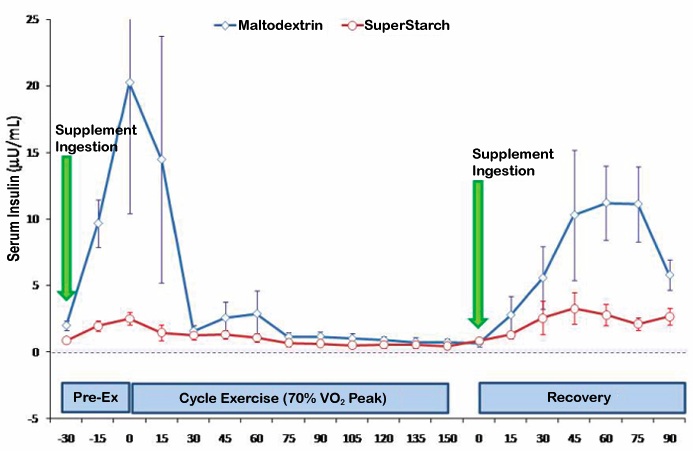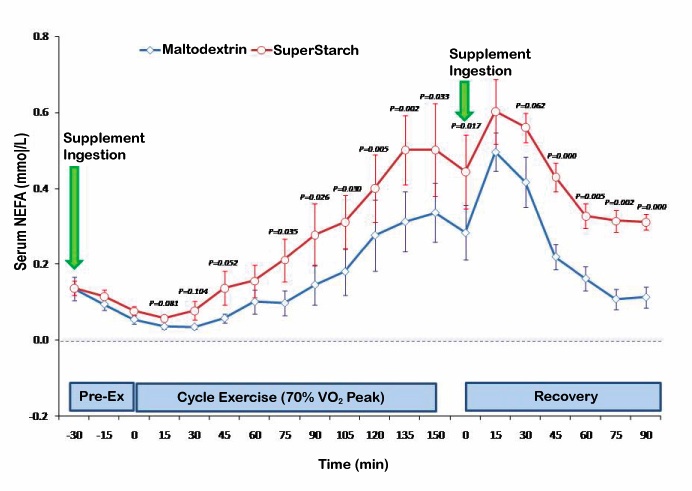I mentioned a couple weeks back that I recently gave a nutrition talk to a U-18 hockey team. The talk started by describing the relationship between glucose, insulin, and other markers of fuel and performance. Without going into excessive detail, the generally ideas can be summarized as:
I’ll come back to this latter point, but this relationship between glucose, insulin, and fat burning is one of the major reasons I’m such a big proponent of Generation UCAN’s SuperStarch products. Simply, unlike most sports drinks, UCAN’s SuperStarch has a less drastic and more prolonged delivery of carbohydrates (think time-release), which significantly diminishes the insulin response AND allows the body to use fat as a fuel source to a greater degree. This means athletes will avoid the spike-and-crash effect of excess sugar consumption that is typical from the sports drinks they consume most frequently.
Check out this data from the University of Oklahoma comparing UCAN to maltodextrin (a carbohydrate source found in most sports drinks).

Note the drastically higher spike in insulin for the maltodextrin drink both pre- and post-training compared to UCAN’s SuperStarch

Note the increased availability of fat for SuperStarch, both pre- and post-training, compared to maltodextrin
Teaching the body to use fat as a fuel source is extremely important, as fat stores are so plentiful that they can basically be thought of as an unlimited source of energy for athletic purposes. Carbohydrates are broken down and used for fuel quicker than fat, meaning it’s a more effective source of energy for high intensity activities (such as during a hockey shift). While we rely on a combination of fuel sources (ATP, PCr, Glycogen/Carbohydrates, Triglycerides/Fat, etc), given that ATP, PCr, and Glycogen best fuel high intensity/short-duration efforts and are in limited supply within the body, it’s reasonable to take steps to conserve these sources for when they’re absolutely necessary. Many players will describe “hitting a wall” or “not having any legs”, which can be related to excessive depletion of carbohydrate stores. The players I’ve worked with that complain of these “symptoms” feel incredible when they switch over to using UCAN before/during games. Consuming a drink (or meal) high in sugar will ensure that the body relies more heavily on carbohydrates for energy on a short-term scale; consuming excessive carbohydrates in the diet will do the same over a long-term scale.
The more we can keep our body OUT of high-intensity mode, or, in other words, limit excessive stressors on the body (think sympathetic nervous system activity), the faster we’ll recover and the longer we can sustain high-level performance. I’m not suggesting that players shouldn’t work hard, only that there are strategies players can take to ensure that they get into high-intensity mode (sympathetic state) when they need to be, and then out of it when they don’t (parasympathetic state).
In a couple days, I’ll follow up on this post with how this idea influences training programs. In the meantime, if you’re interested in learning more about Generation UCAN’s products, check out these posts, which I wrote about a year ago:
If, after reading through those posts and some of the material on their site, you decide you want to pick some up for yourself, you can save 10% by purchasing through this site that we set up for our Endeavor clients link: Generation UCAN
To your success,
Kevin Neeld
Please enter your first name and email below to sign up for my FREE Athletic Development and Hockey Training Newsletter!